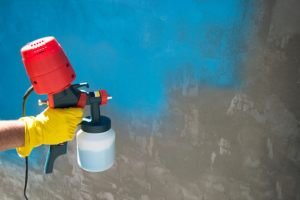A paint gun is like a device that sprays paint and is much more convenient to use as compared to traditional brush painting methods. Whether it’s to paint your home walls or for artists to show their creativity, a paint gun can make the task significantly easier and more fun. Below is a detailed account of how you can become a pro at using a paint gun.
See also: How to paint a ceiling?

Source: Pinterest (acrylgiessen.com)
Paint gun: Types
There are several types of paint guns and have different components which can be altered depending on the surface you wish to paint and the technique you wish to use.
It is very important for you to use a paint gun that best suits your purpose. These guns can be differentiated from each other on the basis of volume and pressure.
There are mainly three types of paint guns, i.e. HVLP (High Volume Low Pressure), which is the best for detailed paintings as it provides finishing, LVLP (Low Volume Low Pressure), which is great for painting smaller sections or for last-minute touch-ups while painting and the third type is a conventional spray paint gun which is the most widely used one too as it is used to paint larger areas such as walls.
Paint gun: Components
The body: The body is the main component which is attached to the nozzle, trigger and paint cup.
Air cap: Air cap can be altered depending on the type of technique you wish to use. It shapes the pattern of the paint.
Nozzle: The nozzle size affects the size of the paint drops and the consistency.
Needle: The needle affects the flow of the paint. If you wish to paint a larger area, you can push the trigger backwards to increase the flow.
Paint cup: As the name suggests, it is a container that holds the paint.

Source: Pinterest (Pittsburgh Spray Equipment)
Tips for using a paint gun
While painting with a paint gun, your workspace should be clean and spacious. Here are a few things that you should keep in mind:
Choose an adequately ventilated workspace: It is important for your workspace to be properly ventilated so that the paint dries easily and the harmful smoke and fumes can escape.
Cover other surfaces properly: Always cover the surfaces that you do not want to paint with a cloth or plastic sheet. You can also entirely remove the objects that you do not wish to paint in order to avoid unwanted splashing.
A clean surface: Make sure that the surface you are going to paint is clean and dust free. Also, make sure that the surface doesn’t need any repairs before painting.
Paint gun: How to set it up?
Now starts the exciting part of working with the paint gun. There are several things that need to be adjusted before you start painting with it:
Change the consistency of the paint (if needed)
The consistency of the paint depends on its type and the surface you wish to paint. Read the instructions behind the paint box to find out whether it needs to be thinned or not.
Air pressure
You can change the air pressure depending on the type of gun you are using and the area you are painting. For example, HVLP guns usually have low pressures, and you can use them for painting over detailed works.
Nozzle size
It is very important to choose the perfect nozzle size depending on the area you’re going to paint. A large nozzle is generally used for a thicker coat.
Paint gun: Practise your technique
- If you are a beginner, always test the gun by painting another surface and familiarise yourself with the controls and the pressure.
- It is also necessary to run a test spray to make sure that you have achieved the desired paint flow.
- You should hold the paint gun firmly at a right angle to the surface.
- Keep the paint gun at a distance of 6-8 inches from the surface that you are painting. This ensures that the paint is smooth and evenly spread.
- Move the gun firmly and evenly to avoid buildup or uneven application of the paint.
- Apply several thin coats instead of a direct thick coat so you can correct yourself if you make any mistakes.
Start painting
Now that you have familiarised yourself with the paint gun, you can start painting.
After you finish your task, you can clean the parts of the paint gun separately to prevent any clogging. It is important to keep your paint gun clean to improve its shelf life.
Whether you are a professional painter or a DIY enthusiast who likes to be creative, a paint gun is the perfect solution for you. With a paint gun, you can fix spots and make touch-ups anytime you want. It is the perfect equipment to start painting as a beginner.
FAQs
How do I change the spray pattern and paint flow of a paint gun?
You can change the pattern by adjusting the air cap or the nozzle, and the paint flow can be changed by pulling the trigger.
How should I clean a paint gun?
You can clean a paint gun by cleaning all its parts separately and dipping it in the cleaning solution. People generally receive a cleaning solution with the paint gun.
What is an airless paint gun?
An airless paint gun is generally used to paint large surfaces or for thicker paints such as latex paint.
Is it necessary to wear gloves while using a paint gun?
Yes, it is necessary to wear safety gear such as goggles, gloves, respirator, etc., especially while working in closed areas. Also, make sure that the space is properly ventilated for the fumes to escape easily.
Is it necessary to thin the paint?
Paint consistency needs to be altered depending on the type of gun you use. You should read the user manual to know if thinning is required.
Can I paint over existing paint with a paint gun?
Yes, just make sure that the surface is dirt free.
| Got any questions or point of view on our article? We would love to hear from you. Write to our Editor-in-Chief Jhumur Ghosh at jhumur.ghosh1@housing.com |
Housing News Desk is the news desk of leading online real estate portal, Housing.com. Housing News Desk focuses on a variety of topics such as real estate laws, taxes, current news, property trends, home loans, rentals, décor, green homes, home improvement, etc. The main objective of the news desk, is to cover the real estate sector from the perspective of providing information that is useful to the end-user.
Facebook: https://www.facebook.com/housing.com/
Twitter: https://twitter.com/Housing
Email: editor@housing.com











